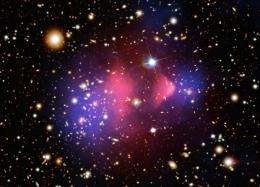A Theory of Dark Matter

Among the most astounding, unexpected, and important achievements of the past century (or even more) have been the discoveries of dark matter and dark energy, collectively dubbed the "dark sector."
A whopping 96% of the essence of our universe lies in the dark sector, where essence refers to everything that controls evolution and large-scale properties of the cosmos. Dark matter is unseen matter -- unseen in the sense that it emits no detected electromagnetic radiation (light, radio waves, etc) -- but it has been definitively spotted nonetheless because its gravity has measurable effects on stars, things that we can see. Of all of the matter in the universe, an incredible 90% is dark matter, with galaxies and stars being only minor constituents. We do not know what dark matter is, only that it is almost surely made of kinds of elementary particles unlike those that comprise normal atoms.
Dark energy, on the other hand, is not a form of matter at all (nor is it literally "dark" -- that is just a poetic way of saying that it is mysterious). It is the source of the outward acceleration of the cosmos, and, based on reasonable assumptions about our current understanding of elementary particle physics, may arise from the vacuum, which has quantum properties that provide energy to the cosmos. Alternatively, dark energy may be a feature of gravity that produces cosmic repulsion on a large scale.
CfA scientist Douglas Finkbeiner, together with three of his colleagues, has published a new paper in Physical Review D with a possible explanation for dark matter.
They are able to approximately describe this astonishing dark matter by making an equally astonishing proposition: the existence of a new force of nature. There are only four known forces in the world: the familiar gravitational and electromagnetic forces, and two forces whose domain is at the scale of the atomic nucleus and are less commonly appreciated, the so-called strong and weak forces.
So far as we know, these are the only forces there are, and scientists have generally supposed that these four will ultimately explain the dark sector as well, once some additional details about particle physics are confirmed with the new generation of particle colliders.
In their new paper, the scientists build on data from five different recent astronomy measurements, most of them probing energetic regimes of astronomy, that have discovered puzzling results including a large excess of high-energy electrons and positrons in space. These particles cannot easily be explained by the conventional sources, shocks from supernova. They could come, however, from the self-annihilation of dark matter particles that, like all known forms of other matter, should come in pairs that self-destruct upon contact. Even without knowing the nature of dark matter, it is possible to argue how it ought to behave so as not to contradict other, known principles and observations.
In working out their self-consistent theory of dark matter, the scientists find that a new, fifth force of nature is implied. Although this might seem an extravagant solution, they argue that it is in fact a relatively straightforward solution, fits into a very reasonable (if novel) picture of particle physics, and fortuitously appears to solve a number of independent problems. The new ideas, if confirmed, would revolutionize our understanding of the universe. This paper, which outlines the basic ingredients of the new model, lays out a concrete first step that subsequent research can now either contradict ... or confirm.
Provided by Harvard College Observatory


















